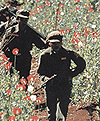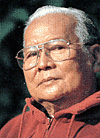
 |
 |
|
Story Wandee Suntivutimetee
Photos Thierry Falise
Ethnicities in Burma are among the most diverse in Southeast Asia, with around 100 spoken
languages. Thirty-two percent of the population are non-Burmese, belonging to various
ethnic groups or hilltribes. These
groups had relative freedom until after WWII when Burma gained independence from England
and a nation-state is formed. The Karen were one of the first groups to begin fighting,
using weapons in guerrilla warfare with the Burmese government. |
 |
|
The Shan town of Homong is known for its military camps. In 1995, more
than 1,000 children under 15 were trained there in the Tiger Camp before Kun Saa, the
heroin king and Tai leader, decided to lay down weapons, causing the Tai army to break
apart into smaller less efficient groups under spearate leaders.
|
| |
|
The Wa, most feared
because of their scalping tradition, the Karenni and Mon have each reached different
stages of various diplomatic means and cease-fire agreements. Only the Karen, the largest
ethnic group, continue
to fight an enemy who continues to rape, loot, burn, and kill. |
 |
|
Over 16,000 ethnic refugees are currently dispersed throughout the 18
camps along the Thai-Myanmar border (figures as of Jan. 2000). Another 10,000 or so live
in 3 camps on the Burmese side. The Thai government still refuses aid to these refugees.
Its flexible engagement foreign policy, however, supports gas pipelines and the Salween
Dam as well as many more huge investment opportunies. How long are we going to avoid
facing the Burmese and ethnic minority problem and wish that it would just go away? |
| |
|
|